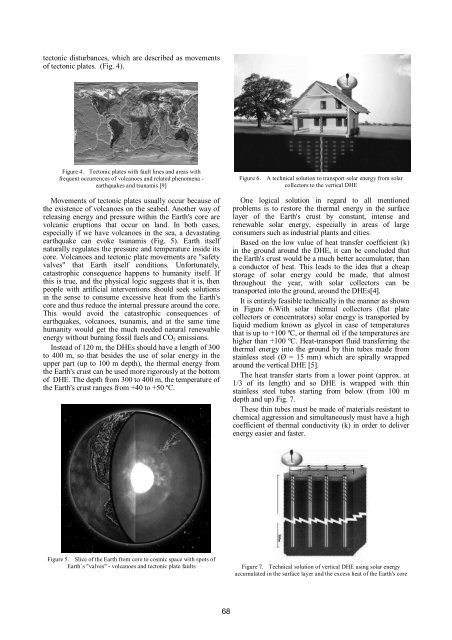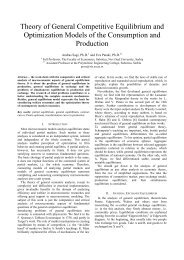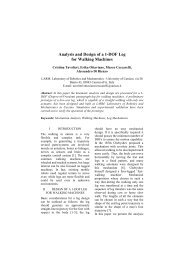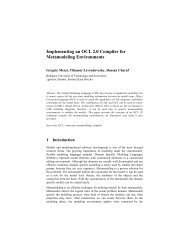tectonic disturbances, which are described as movementsof tectonic plates. (Fig. 4).Figure 4. Tectonic plates with fault lines and areas withfrequent occurrences of volcanoes and related phenomena -earthquakes and tsunamis [9]Movements of tectonic plates usually occur because ofthe existence of volcanoes on the seabed. Another way ofreleasing energy and pressure within the Earth's core arevolcanic eruptions that occur on land. In both cases,especially if we have volcanoes in the sea, a devastatingearthquake can evoke tsunamis (Fig. 5). Earth itselfnaturally regulates the pressure and temperature inside itscore. Volcanoes and tectonic plate movements are "safetyvalves" that Earth itself conditions. Unfortunately,catastrophic consequence happens to humanity itself. Ifthis is true, and the physical logic suggests that it is, thenpeople with artificial interventions should seek solutionsin the sense to consume excessive heat from the Earth'score and thus reduce the internal pressure around the core.This would avoid the catastrophic consequences ofearthquakes, volcanoes, tsunamis, and at the same timehumanity would get the much needed natural renewableenergy without burning fossil fuels and CO 2 emissions.Instead of 120 m, the DHEs should have a length of 300to 400 m, so that besides the use of solar energy in theupper part (up to 100 m depth), the thermal energy fromthe Earth's crust can be used more rigorously at the bottomof DHE. The depth from 300 to 400 m, the temperature ofthe Earth's crust ranges from +40 to +50 ºC.Figure 6. A technical solution to transport solar energy from solarcollectors to the vertical DHEOne logical solution in regard to all mentionedproblems is to restore the thermal energy in the surfacelayer of the Earth's crust by constant, intense andrenewable solar energy, especially in areas of largeconsumers such as industrial plants and cities.Based on the low value of heat transfer coefficient (k)in the ground around the DHE, it can be concluded thatthe Earth's crust would be a much better accumulator, thana conductor of heat. This leads to the idea that a cheapstorage of solar energy could be made, that almostthroughout the year, with solar collectors can betransported into the ground, around the DHEs[4].It is entirely feasible technically in the manner as shownin Figure 6.With solar thermal collectors (flat platecollectors or concentrators) solar energy is transported byliquid medium known as glycol in case of temperaturesthat is up to +100 ºC, or thermal oil if the temperatures arehigher than +100 ºC. Heat-transport fluid transferring thethermal energy into the ground by thin tubes made fromstainless steel (Ø = 15 mm) which are spirally wrappedaround the vertical DHE [5].The heat transfer starts from a lower point (approx. at1/3 of its length) and so DHE is wrapped with thinstainless steel tubes starting from below (from 100 mdepth and up) Fig. 7.These thin tubes must be made of materials resistant tochemical aggression and simultaneously must have a highcoefficient of thermal conductivity (k) in order to deliverenergy easier and faster.Figure 5. Slice of the Earth from core to cosmic space with spots ofEarth´s "valves" - volcanoes and tectonic plate faultsFigure 7. Technical solution of vertical DHE using solar energyaccumulated in the surface layer and the excess heat of the Earth's core68
If the walls of the DHEs are made of aluminum, orcomposite materials containing aluminum in its structure,the coefficient of thermal conductivity’s value would be k= 200 W/mK or as a composite material with value of k =50 W/mK and if such is the case, could easily warm andtransform the thermal energy to liquid medium (glycol)inside the DHE and finally heat pumps. Under suchcircumstance might subtract heat from the ground between10 and 20º C, which is several times more energy thanusing the current methods of exploitation. It is importantto emphasize that DHE system would be stable in terms ofheat capacity and it could reach 0,15 to 0,35 kW/m 2 . Inother words, a 300 m long DHE could give at least 30kWh of energy to heat pumps with the assurance thatenergy will be renewed continuously. The quantity ofexploited thermal energy depends on the surface area ofthe DHE, temperature conditions of the ground, thecoefficient of thermal conductivity (k) of the materialaround the probe, the material from which the probe andthe liquid media (water or glycol) are made of. The DHEsdepth of up to 15 m can be insulated from the outside andcannot exchange heat with the external environment.During one heating season under above mentionedconditions, temperature around DHE can deliver about100 MW of thermal energy from ground, which is severaltimes more than today's conventional results.If the boreholes would be secured with technology ofcementing, it should be done with materials that would behygroscopic. Namely, hygroscopic materials would drawmoisture - water and thus the thermal energy would befaster drained in this case, since the c coefficient ofthermal conductivity of water is, k = 0.83 W / m K and thespecific heat capacity of water is c = 4190 J / kgK. Wateris, indeed, the best medium for the transfer of thermalenergy and this property can be utilized in the Earth's crustusing DHEs.In order to quickly and easily drill deeper (300 to 400m), it is necessary to develop an entirely new type of heatexchanger that could be use simultaneously for drillingand later on settle and ensure the borehole itself. Filling ofthe boreholes could then be omitted if such pipes can takethe pressure. Within these probes after the completion ofdrilling, pipes are lowered with glycol, which transportsthe heat taken by the heat pump.III.CONCLUSIONSThis paper offers new technical solution using acombination of two thermal energy sources: the Sun andthe Earth's core. (Figure 8.)Figure 8. The sun and the Earth´s crust - inexhaustible sources ofcheap and environmental-friendly renewable energy for life on Earth[10]Figure 9. Benefits of changes - no icy roads and sidewalks in largecitiesThe general belief of physicists for a long time andeven until today is that the accumulation of heat in theEarth's crust is not possible because of its large mass andrelatively high coefficients of thermal conductivity (k) formaterial; Earth's crust is built up (Table 1). Thesepresumptions are even more theoretically wrong sincethese materials have thick layers. Consequently it is not soimportant that the coefficients of thermal conductivity ofthese materials in Earth's crust have higher values thanusual insulation materials. Heat resistance during heattransfer will definitely be more loaded in view of the largewidth (d) of layers. After all it can be clearly concludedfrom (2).Specifically, this impossibility of fast (equalization)inflow of thermal energy by the thermodynamic laws, inwhich limits the capacity and service life of heat pumps aswell as demonstrating clearly that the Earth's crust couldbe a better conductor for heat rather than an accumulator.We had also stated 2 evidences for this claim: the exampleof heat pumps with DHEs from Sweden and the wellknown Roman system of underfloor heating that had beenproven for centuries. All this suggest that it could bepossible to accumulate thermal energy in the earth andmost likely it can be accomplished easier with solarenergy - as with an inexhaustible source.Accumulation of solar energy around the vertical DHEon the surface of the Earth's crust (depths up to 100 m) isalmost possible all year. Furthermore, a DHEs length of300 to 400 m instead of 120 m is proposed in order tobe more efficient and reach the surplus thermal energyfrom the Earth's core in greater quantities. These measurescould fully support heat pumps, and even improved theircoefficient of performance (COP) with an excellent valuefar above 6. Through this a rational solution of using acompletely renewable ecological energy source would begranted which is applicable on bigger scale for heatingand cooling large industrial facilities, resorts and evenmajor cities (Fig.9.). A high class energy efficiency of A +can also be achieved. Buildings in average, the leadingconsumers of energy in the world, use 50% of the totalproduced energy. The consumption can enormously bereduced up to 15% using the described solution.Dangerous energy sources like nuclear power as well asfossil fuels can be completely avoided from being use.There is a possibility with deeper boreholes of up to 1500m and by thermal oil as a medium for heat transfer, and tobuild electric power plants of few hundred MW. DHEscan even supply steam turbine by taking a part of theEarth's core heat and a fraction from the large solar69
- Page 1 and 2:
4 4 th IEEE International Symposium
- Page 3 and 4:
EXPRES 20124 th International Sympo
- Page 5 and 6:
Application of Thermopile Technolog
- Page 7 and 8:
Design of a Solar Hybrid System....
- Page 9 and 10:
___________________________________
- Page 11 and 12:
environmental protection and global
- Page 13 and 14:
But can we use the human body sweat
- Page 15 and 16:
IX. REFERENCES[1] Todorovic B. Cvje
- Page 17 and 18:
QQ⎛ Λt⎞=⎜⎟⎝ Λ ⎠Nt Nwh
- Page 19 and 20: Analysis of the Energy-Optimum of H
- Page 21 and 22: V. OBJECTIVE FUNCTIONThe objective
- Page 23 and 24: The Set-Up Geometry of Sun Collecto
- Page 25 and 26: continuous east-west sun collector
- Page 27 and 28: continuously measure the thermal ch
- Page 29 and 30: CEvaluation of measurement resultsA
- Page 31 and 32: Application of Thermopile Technolog
- Page 33 and 34: Temperature of the components [C]90
- Page 35 and 36: nighttime, to weather or to the cha
- Page 37 and 38: η uη u0.50.40.30.20.1T 1 - 400K0.
- Page 39 and 40: Figure 10. . SPS Concept illustrati
- Page 41 and 42: [16] Zoya B. Popović: Wireless Pow
- Page 43 and 44: 25.0020.0015.0010.005.000.00Figure
- Page 45 and 46: · ℃ 0.0738 · 1.209 0.0892
- Page 47 and 48: use may be advantageous not only in
- Page 49 and 50: To find the reasons for this disagr
- Page 51 and 52: Toward Future: Positive Net-Energy
- Page 53 and 54: EnergyPlus environment, we used mod
- Page 55 and 56: To keep future energy consumption d
- Page 57 and 58: A New Calculation Method to Analyse
- Page 59 and 60: On Fig. 3. can be seen the areas th
- Page 61 and 62: Present and Future of Geothermal En
- Page 63 and 64: TABLE II.THE TEMPERATURE DATA AND C
- Page 65 and 66: Error in Water Meter Measuring at W
- Page 67 and 68: III.RESULTS OF MEASURMENTSEach meas
- Page 69: TABLE I.THE AVERAGE VALUE OF THERMA
- Page 73 and 74: Environmental External Costs Associ
- Page 75 and 76: iodiesel production facility with a
- Page 77 and 78: Contribution of unit processesto ex
- Page 79 and 80: Heat Pump News in HungaryBéla Ád
- Page 81 and 82: Thermal Comfort Measurements In Lar
- Page 83 and 84: IV.DISCUSSIONThe sample frequencies
- Page 85 and 86: For a Clear View of Traditional and
- Page 87 and 88: esults in geographically distribute
- Page 89 and 90: Design of a Solar Hybrid SystemMari
- Page 91 and 92: Maintaining the set point temperatu
- Page 93 and 94: Decision system theory model of ope
- Page 95 and 96: parameter of pump in the function o
- Page 97 and 98: Importance and Value of Predictive
- Page 99 and 100: D. Overview of existing boiler oper
- Page 101 and 102: HEAVY FUEL OIL FIRED, STEAMNATURAL
- Page 103 and 104: MATHEMATICAL MODEL AND NUMERICAL SI
- Page 105 and 106: C. Energy balance equationMathemati
- Page 107 and 108: Discretization energy balance equat
- Page 109 and 110: T ulf=32 º C, A - m =0.00162 kg/s,
- Page 111 and 112: Comparison of Heat Pump and MicroCH
- Page 113 and 114: the microCHP development. The energ
- Page 115 and 116: control and stabilizer must be deve
- Page 117 and 118: In Figure 1, in relation to the ord
- Page 119 and 120: NPCC BHXOBYNI x1I x2I x3I x4LO YKYO
- Page 121 and 122:
exchange, as in reality, economies
- Page 123 and 124:
esponsibilities for consequences, o
- Page 125 and 126:
Coca-Cola Enterprise Inc had approx
- Page 127 and 128:
Flow Pattern Map for In Tube Evapor
- Page 129 and 130:
circumference with a liquid film. T
- Page 131 and 132:
Tube diameter: d 6 mm W Heat flux
- Page 133 and 134:
Realization of Concurrent Programmi
- Page 135 and 136:
applications the development, optim
- Page 137 and 138:
Renewable energy sources in automob
- Page 139 and 140:
commercial arrays can be built at b
- Page 141 and 142:
of multiple thin films produced usi
- Page 143:
EXPRES 20124 th International Sympo












